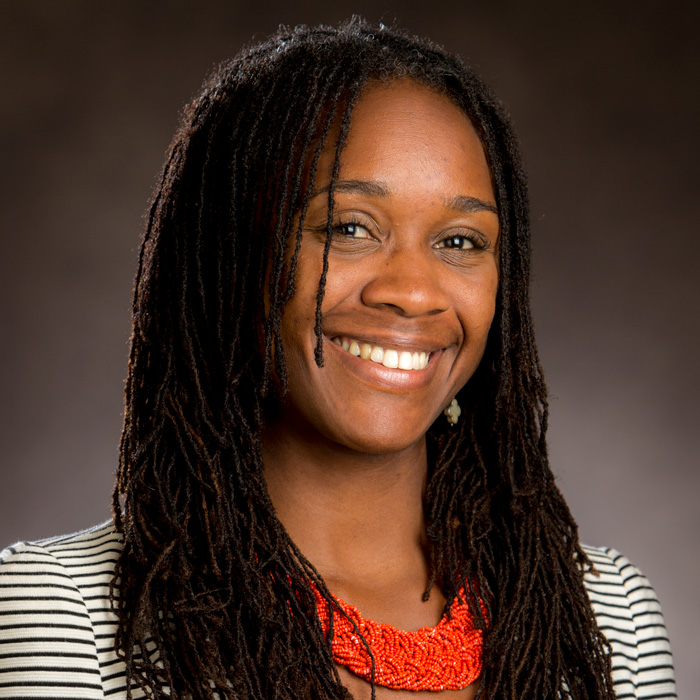Digging Deep for Diversity

By John Helsley
The face of Corporate America is often that of a white man. There’s not much debate about that.
But Lex Smith-Washington, an assistant professor in the Spears School of Business at Oklahoma State University, decided to take a deep look at the few black women who have succeeded in rising to the upper ranks of their companies.
Smith-Washington’s study, compiled with three colleagues, dug deep into the issue of a lagging rise of black women into executive roles in corporate America.
The research, published in the Harvard Business Review, found focus among those who succeeded.
“We started off asking black women executives, ‘What has been your secret sauce?’” Smith-Washington said. “‘What has worked for you? What has been great in corporate? What have been barriers? What have been opportunities in places where you needed to grow and develop in order to work these relationships?’”
The answers, Smith-Washington said, offer hope for a bigger breakthrough.
From an original project interviewing more than 200 women executives within four levels of the CEO and examining their experiences in the corporate world, Washington and her three co-authors — Marla Watkins and Jamie Ladge of Northeastern University, and Pamela Carlton of Springboard-Partners in Cross Cultural Leadership — ultimately focused on the journeys of black women in those roles.
Two sets of interviews with 59 black women took place; the first was in 2007 before the global financial crisis, then a follow-up in 2014. The time between the two interviews and the expanded experiences of the women provided optimum feedback.
“The chance to visit with them twice and to pull together their stories was something I couldn’t turn down,” Smith-Washington said. “It forced me to learn some new skills in terms of research, but it’s been one of the more rewarding projects of my career.”
Smith-Washington and her team found the women faced various challenges in their plans to rise through the executive ranks. Black women make up 12.7 percent of the population, yet only 1.3 percent are in senior management and executive roles of S&P 500 firms. There is not a single black female CEO in the Fortune 500, and only 2.2 percent sit on Fortune 500 boards of directors.
Some of the hurdles found were common, including race and gender. Yet the issues weren’t necessarily conventional but often a product of “intersectional invisibility.”
“Almost all of them talked about being invisible at work,” Smith-Washington said. “You have these black women, and they’re the only one around, you’d think it would make them very visible. Ironically, it made them also invisible.
“We don’t like to talk about our race and gender. We’re all afraid that we’re going to say the wrong thing. So, frequently, when you’re the only one, people just avoid you.”
The researchers discovered key factors for the women in navigating their paths and becoming visible hinged on keen self-awareness.
“They had to be completely aware of what it meant to be a black woman in corporate America,” Smith-Washington said. “What it meant for other people. And how they were going to manage other people’s expectations, stereotypes, positive and negative associations with black women.”
From there, the women took the initiative in forming relationships, finding common bonds such as family or sports that would lead to mentorships and sponsorships among top executives within their companies, enhancing their visibility.
In gaining credibility in their environments, the women often took bold chances professionally, proving themselves on the big stage.
“I think there’s something unique about black womanhood,” Smith-Washington said. “I can speak as a black woman: Many of their stories resonated with me, these stories around sort of the cultural upbringings that many of us have, where we learn to be very strong and be very forward with our ideas. And when we’re clear on something, we work hard at it.
“These women talked about that. Not only about being great at what you do, and having all the necessary skills and abilities and some women called it the ‘juice’ to get this stuff done, but also having the wherewithal to say, ‘I know I have the requisite skills. What I need to do now is to convince you that this is the right plan.’
“There was always this dance between being bold but also in bringing people along.”
Maybe now these women, with their research, can help bring others along.
“To me, when I look at this research, hope is probably one of the major words that comes out,” Smith-Washington said. “I’m hopeful because there is so much that can be learned from what they have done. There’s so much that can be packaged and put into tiny little manuals for the rest of us to follow and learn from and mimic.
“So that makes me hopeful for what we can all do individually, for each other and for ourselves.”
Read It
The research by Smith-Washington and her co-authors was highlighted by the Harvard Business Review in May. Read it at okla.st/2JOwxsL.

